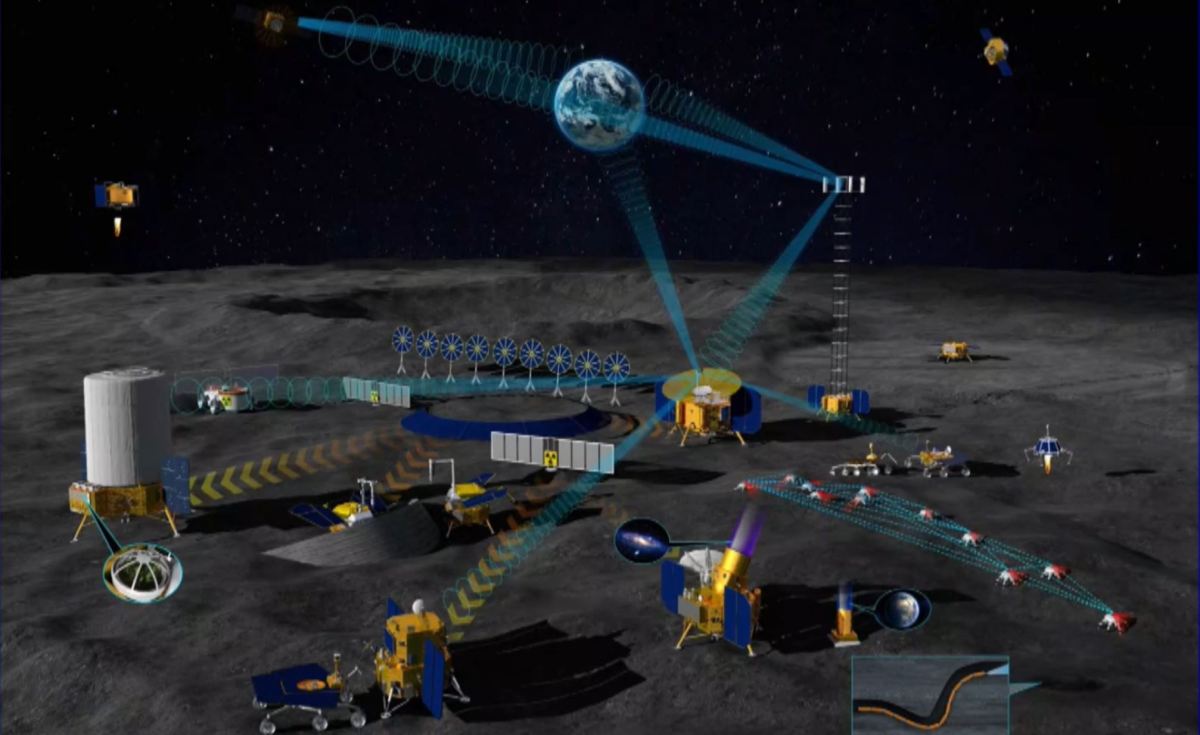HELSINKI — Russia and China unveiled a roadmap for a joint International Lunar Research Station Wednesday to guide collaboration and development of the project.
Chinese and Russian space officials revealed the plans June 16 at the Global Space Exploration (GLEX) conference in St. Petersburg, Russia, stating that the ILRS has received the interest of a number of countries and organizations.
The ILRS is planned to be developed concurrently but separate to the United States’ Artemis lunar exploration program.
Wu Yanhua, deputy head of the China National Space Administration (CNSA), introduced the science objectives, facilities and transportation, lunar surface infrastructure, development phases and cooperation frameworks for the venture.
The first phase of ILRS, noted as reconnaissance, involves gathering data and verifying high-precision soft-landings across 2021-25 with the Chinese Chang’e-4, -6 and -7 missions, Russia’s Luna 25, 26 and 27 and possible missions of partners.
The second “construction” phase consists of two stages (2026-30, 2031-35). The first involves technology verifications, sample return, massive cargo delivery and the start of joint operations. Planned missions are Chang’e-8 and Luna 28 and potential international contributions.
The second stage looks to complete on-orbit and surface infrastructure for energy, communications, in-situ resource utilization and other technologies. Missions named ILRS-1 through 5 would focus respectively on energy and communications, research and exploration facilities, in-situ resource utilization, general technologies and astronomy capabilities. Russian super heavy-lift launch vehicles are listed to launch the missions.
The final “utilization” phase beyond 2036 would see the start of crewed landings. CNSA later published English and Chinese versions of the roadmap on its web pages while Roscomcos shared a presentation video on Twitter.
Spacecraft shown in the video include orbiters and relay satellites, descent and ascent vehicles, surface infrastructure for energy and communications, hopping robots and intelligent mini rovers.
The location of the ILRS is yet to be decided. Possible destinations noted in the presentation were Aristarchus crater and Marius Hills in the northwest of the lunar near side and Amundsen crater near the south pole.
Sergey Saveliev, deputy director general for International Cooperation for Roscosmos, said it was “difficult to overestimate the scientific significance of the project”.
Russia and China signed a memorandum of understanding on the ILRS in March. International partners were openly invited on the sidelines of the Scientific and Technical Subcommittee of the United Nations’ Committee on the Peaceful Uses of Outer Space (COPUOS) April 23.

China and Russia presented five cooperation domains in which prospective partners could collaborate. Wu said the parties hoped to produce a legal document detailing the principles of the ILRS before the end of the year.
Saveliev and Wu stated that discussions had taken place with the European Space Agency and CNES of France, while Thailand, Saudi Arabia and the United Arab Emirates had expressed interest in the project. Wu noted however that the discussions were at a very early stage.
The development follows Brazil becoming the 12th nation to join the Artemis Accords, the U.S.-led effort to establish norms of behavior for space exploration.
Marco Aliberti, a resident fellow at the European Space Policy Institute in Austria, told SpaceNews that ILRS development “signals the progressive bifurcation of the international space community around two contending – and potentially conflicting – pathways for future lunar exploration activities.”
“To be sure, like the Artemis programme, the Moon base project conceived by China and Russia has been purposefully opened to international partners at all levels. And even if participation in the US-led Artemis would not per se preclude a possible participation in the ILRS, reality is that the two projects are to large extent mutually exclusive in terms of partnership configurations.”
The contending “international lunar exploration efforts can generate some potentially beneficial effects from a scientific, technological and industrial perspective,” says Aliberti. At the same time, it will “indirectly produce harmful spillover effects on the current international efforts towards the more cooperative space environment and eventually undermine international security and strategic stability, be it in space and here on Earth.”
The ILRS is at its early stages, with many other priorities and challenges ahead. Wu also remarked that the presentation was a “version one” of the roadmap.
Asked when Chinese citizens would first walk on the moon, Wu stated that the focus was on the Chinese Space Station following the recent launch of the Tianhe module and declined to provide a date. The Shenzhou-12 crewed mission is due to launch for Tianhe from Jiuquan at 9:22 p.m. Eastern, June 16.

